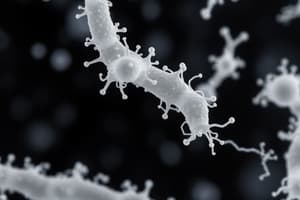Podcast
Questions and Answers
What is the primary purpose of serotyping in microbiology?
What is the primary purpose of serotyping in microbiology?
- To visualize antigen-antibody reactions
- To determine the antibiotic resistance of bacteria
- To amplify DNA or RNA segments
- To identify and classify bacterial species and strains (correct)
Which test is specifically designed to detect HIV antibodies?
Which test is specifically designed to detect HIV antibodies?
- Polymerase Chain Reaction (PCR)
- Serotyping
- Western Blot Test (correct)
- Enzyme-Linked Immunosorbent Assay (ELISA)
What characteristic does specificity in immune testing refer to?
What characteristic does specificity in immune testing refer to?
- The detection of a broad range of antigens
- Identifying multiple pathogens at once
- The ability to differentiate between closely related antigens (correct)
- Detecting even small quantities of antigens or antibodies
What is the main function of probes in hybridization techniques?
What is the main function of probes in hybridization techniques?
What is a key benefit of using the Polymerase Chain Reaction (PCR)?
What is a key benefit of using the Polymerase Chain Reaction (PCR)?
What does phenotypic methods focus on when identifying microorganisms?
What does phenotypic methods focus on when identifying microorganisms?
Which of the following statements is true regarding immunologic methods?
Which of the following statements is true regarding immunologic methods?
Which advantage does genotypic methods have over phenotypic methods?
Which advantage does genotypic methods have over phenotypic methods?
Which sampling method is best suited for analyzing spinal fluid?
Which sampling method is best suited for analyzing spinal fluid?
What is a crucial factor in the success of specimen collection for microbial identification?
What is a crucial factor in the success of specimen collection for microbial identification?
Viable non-culturable (VNC) organisms are identified through which method?
Viable non-culturable (VNC) organisms are identified through which method?
Which of the following is NOT a typical sampling site for microbial identification?
Which of the following is NOT a typical sampling site for microbial identification?
What is the primary goal of using direct microscopic examination in phenotypic methods?
What is the primary goal of using direct microscopic examination in phenotypic methods?
Which type of media is specifically used to encourage the growth of only the suspected pathogen?
Which type of media is specifically used to encourage the growth of only the suspected pathogen?
What does the Mycobacterial growth indicator tube (MGIT) primarily detect?
What does the Mycobacterial growth indicator tube (MGIT) primarily detect?
Antibody titers are used to measure what aspect of a patient's serum?
Antibody titers are used to measure what aspect of a patient's serum?
What characterizes differential media?
What characterizes differential media?
In immunochromatography, what happens if the sample contains the correct antigen?
In immunochromatography, what happens if the sample contains the correct antigen?
What is the main purpose of phage typing in microbiology?
What is the main purpose of phage typing in microbiology?
Which of the following best describes immunologic methods?
Which of the following best describes immunologic methods?
What type of key is used to separate primary genera of various cocci based on staining and growth results?
What type of key is used to separate primary genera of various cocci based on staining and growth results?
Flashcards
Phenotypic methods
Phenotypic methods
Identifying microbes based on observable characteristics like enzyme activities, growth conditions, and antibiotic susceptibility.
Immunologic methods
Immunologic methods
Identifying microbes by detecting specific antibodies against the suspected pathogen in a patient sample.
Genotypic methods
Genotypic methods
Identifying microbes by analyzing their genetic material (DNA or RNA).
Viable Non-Culturable (VNC) microbes
Viable Non-Culturable (VNC) microbes
Signup and view all the flashcards
Specimen collection
Specimen collection
Signup and view all the flashcards
Aseptic technique
Aseptic technique
Signup and view all the flashcards
Sampling sites
Sampling sites
Signup and view all the flashcards
Microscopic observation
Microscopic observation
Signup and view all the flashcards
Gram Stain
Gram Stain
Signup and view all the flashcards
Selective Media
Selective Media
Signup and view all the flashcards
Differential Media
Differential Media
Signup and view all the flashcards
Dichotomous Key
Dichotomous Key
Signup and view all the flashcards
Biochemical Testing
Biochemical Testing
Signup and view all the flashcards
Antibody Titer
Antibody Titer
Signup and view all the flashcards
Immunochromatography
Immunochromatography
Signup and view all the flashcards
Serology
Serology
Signup and view all the flashcards
Serotyping
Serotyping
Signup and view all the flashcards
Western Blot Test
Western Blot Test
Signup and view all the flashcards
ELISA
ELISA
Signup and view all the flashcards
Specificity (diagnostic test)
Specificity (diagnostic test)
Signup and view all the flashcards
Sensitivity (diagnostic test)
Sensitivity (diagnostic test)
Signup and view all the flashcards
Study Notes
Microbial Identification Methods
-
Phenotypic Methods: Observe organism appearance and behavior. Examples include enzymatic activities, environmental conditions for growth, and susceptibility to antibiotics.
-
Immunologic Methods: Detect specific antibodies to a suspected pathogen in a patient sample. This often involves faster laboratory kits for identification.
-
Genotypic Methods: Examine genetic material for identification. These methods are often more precise and automated, and don't always require growth of the microorganism. They can identify viable, non-culturable microbes.
Specimen Collection
- Specimen collection success depends on proper techniques. Aseptic techniques (free of microbes) are crucial, such as keeping containers and tools sterile. Sample only the infected site, avoiding surrounding areas.
Phenotypic Methods (Detailed)
-
Immediate Direct Examination: Microscopic observation is a rapid method for determining characteristics. Common stains include Gram stain and acid-fast stain.
-
Selective and Differential Growth: Specialized media can encourage growth of specific pathogens present in small numbers. Selective media allows only target bacteria to grow, while differential media visually distinguishes microbes.
Biochemical Testing
- Physiological reactions to nutrients & substrates of bacteria provide evidence of the enzyme systems present in a species. The Mycobacterial Growth Indicator Tube (MGIT) detects slow-growing mycobacteria (like Mycobacterium tuberculosis).
Immunologic Methods (Serology)
-
In vitro testing of serum, urine, cerebrospinal fluid, or tissue samples for specific antibodies.
-
Immunochromatography (Lateral Flow Test): Used for rapid tests, like pregnancy tests and COVID-19 tests, as they detect antigens or antibodies in a sample.
-
Antibody Titers: Determine the concentration of antibodies in a sample. Used to diagnose autoimmune disorders, determine past exposures, and identify specific bacterial strains. Methods including titration to dilutions.
Genotypic Methods (PCR)
-
Polymerase Chain Reaction (PCR): Creates many copies of DNA or RNA to identify microbes quickly.
-
Hybridization: Analyzes genetic material segments for identification. Probes (segments of DNA or RNA) can be used in a process called Fluorescence in situ hybridization (FISH) to identify a microbe.
Additional Methods
-
Electrophoresis: Separating antibodies and antigens using electrophoresis to detect their presence.
-
Enzyme-Linked Immunosorbent Assay (ELISA): Visualizes antigen-antibody reactions, commonly used in clinical laboratory diagnosis. Relies on solid supports (like microtiter plates).
Studying That Suits You
Use AI to generate personalized quizzes and flashcards to suit your learning preferences.




